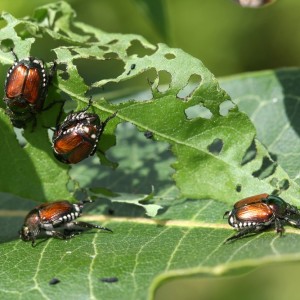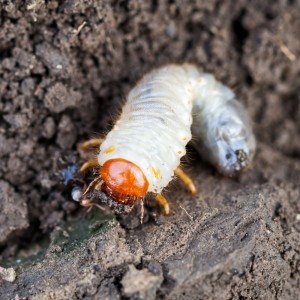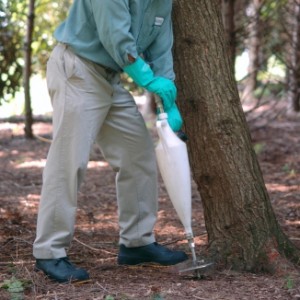 6 Facts about Japanese Beetles
6 Facts about Japanese Beetles
Did you know your property could be the site for a Beetle Buffet this summer? Japanese Beetles and other beetles emerge as flying adults sometime in the middle of summer. After emerging, they feed for roughly a month. Beetles cause substantial damage to trees, shrubs, and flowers in the landscaping at almost every property. Even though these pests are well-known, there’s still lots of information you may not know about Japanese Beetles. Much of what follows applies to other beetles that may be feeding on your landscape, too.
1) Beetle feeding is predictable
Japanese Beetles, Northern Masked Chafers, and other beetles are attracted to very specific plants. These pests prefer very specific plants and are attracted by specific plant odors, colors, and in specific locations. If your plants are located in the sun, they will probably be more likely to be hit by beetles. This isn’t a hard and fast rule, but a good guide for where to look. Likewise, you’ll find some plants that will rarely get damaged and some that are a Japanese Beetle’s favorite treat.
2) Beetle feeding attracts even more beetles
As plants are damaged by the feeding of Japanese Beetles and other beetles, they release certain chemical compounds. These chemicals will attract additional beetles. These odors can carry in the wind for several hundreds of yards.
 3) Killing grubs in your lawn won’t insure you don’t have beetle damage
3) Killing grubs in your lawn won’t insure you don’t have beetle damage
Preventing grubs in your lawn is a great lawn care tactic to keep your turf from being damaged in late summer or early fall. However, beetles are good fliers and travel several miles from where they emerge to feed and mate. A lot of times, beetles lay eggs in landscape beds as well as lawns. This is particularly true if the ground is dry and hard. Then, grubs later turn into beetles, which feed on the plants above.
4) Just because you don’t see Japanese Beetles on your plants, doesn’t mean you won’t get beetle damage
A lot of people are perplexed by having beetle damage without ever seeing Japanese Beetles on their plants. The reason is it may be a different type of beetle such as Northern Masked Chafers which predominantly feed at night the same time of year that Japanese Beetles are active.
5) Milky Spore isn’t a great method to control beetles
Although somewhat effective in some areas, soil conditions, product variability, and grub resistance commonly interferes with this method of grub control. Spores can take 2-3 years to build up in the soil and this material only works on Japanese Beetle grubs and not some other common beetle grubs. Just treating your property with this material won’t insure you against beetles flying from the surrounding miles.
6) Japanese Beetle traps may make your problem worse
Even if you put the trap as far as possible from your prized plants, these traps synthesize the chemicals that beetles are attracted to in significantly higher strengths. Using beetle traps is like putting a neon sign in your lawn for beetles to come chow down. Their strength of attracting beetles outweighs their ability to trap them, leaving nearby plants still susceptible and having a greater potential to be damaged than without traps nearby.
Practices to Help Control Japanese Beetles
Beetles are bound to find their favorite meal if it’s on your property. However, there are some methods that can drastically reduce the damage you may find.
Plant Alternatives
If you can remove and replace, or initially select other varieties of plants, you can keep beetles from frequenting your property. Having a landscape designer select different plants such as a Forest Pansy Redbud instead of a Purpleleaf Plum tree is just one example of a plant choice that can drastically influence beetle damage on your property.
 Preventative Treatments
Preventative Treatments
Certain trees and shrubs can be treated in the spring to reduce beetle damage in the summer. Having a tree service perform soil-applied systemic insecticide treatment in the spring will allow these plants to circulate this material into the leaf tissue of these plants so that it is less attractive to beetles and can even help to kill beetles to some degree while they attempt to feed. Beetles that begin to feed on these plants will often find another plant to feed on, leaving only minimal damage.
Spraying for Beetles
When beetles are active, you can have a tree service spray trees and shrubs to help control them. This material only lasts for a few days or a week at max, and needs to be re-applied during the 4-6 weeks while beetles are active.
Cover Plants
This may not be practical for larger plants, but installing netting over some plants in pots, etc. may help to keep beetles from doing damage for the 4-6 weeks they are actively feeding.
We’re Here to Help
If you are interested in Japanese Beetle control or help with other types of beetles feeding on your trees and shrubs, we would be happy to talk to you.

